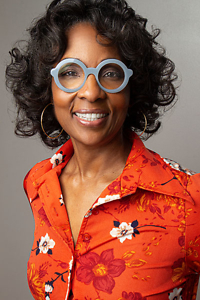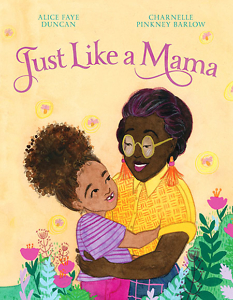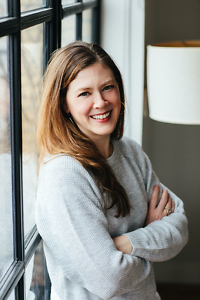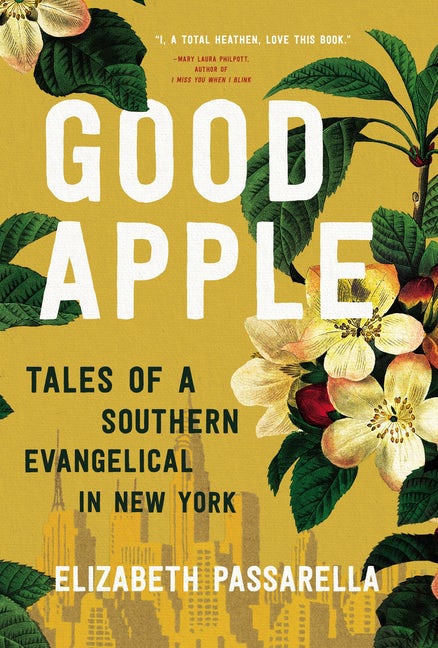Unconditional Love 101
Alice Faye Duncan’s Just Like a Mama explores the bond between a child and the grandmother raising her
It was in the early 1990s that the story for Alice Faye Duncan’s latest picture book, Just Like a Mama, was born. Fast forward a decade or three, and it is on shelves, thanks to Denene Millner’s relatively new imprint at Simon & Schuster Books for Young Readers. This bighearted story, illustrated by Charnelle Pinkney Barlow, is a particularly welcome one for adopted children and all those being raised by extended family and other non-parent caregivers, whose stories are not often told in picture books.

Carol Olivia Clementine tells readers all about her grandmother and caregiver, Mama Rose. “Mama and Daddy live miles away,” Carol Olivia says. “I wish we lived together.” But Mama Rose gets the job done, showering her granddaughter with love, as well as disciplining her kindly and firmly in the ways a loving parent does. She is “just like a mama” to Carol: “Mama Rose is my home. She loves me like a mama.”
Duncan, who has written eight previous children’s books and is a school librarian in Memphis, found inspiration for this story in her students, as well as in her personal life. Chapter 16 asked her questions via email.
Chapter 16: Can you talk about your Aunt Pat and your own upbringing that inspired this story, as mentioned in the closing author’s note in the book?
Alice Faye Duncan: I wrote Just Like a Mama to celebrate and affirm adopted children. I also wrote it to acknowledge the aunts, grandmothers, and big sisters who cheerfully care for children not their own. My mother inspired this book. She adopted her little sister when my grandmother died. Mama was 28 years old. Her sister, Pat, was 10. Their heart connection taught me a great lesson. Love is the tie that binds.
Chapter 16: You also mention your students in the author’s note. Many of them experience success while in the care of “grandmothers, aunts, and big sisters.” What is another way that your work as a school librarian informs your writing?
Duncan: I look for holes in the curriculum. For example, school libraries are filled with books about the civil rights movement. Students know about Dr. King marching in Selma. Students don’t know that Dr. King died in Memphis fighting for economic justice. I wrote that history to fill the hole. All my nonfiction picture books highlight important, but obscure, historical moments. All my fiction books are lyrical poems that celebrate the joy of childhood.
Chapter 16: It’s been wonderful to see the books that have come from Denene Millner’s imprint. What was it like to work with her?
Duncan: I wrote the first draft for Just Like a Mama in 1993. That was also my first year teaching school. Over the next two decades, I would revisit the text. I believed adopted children and forever parents deserved to see themselves in books. Denene Millner agreed with me in 2017. Then she went on a journey to champion the book into publication. Denene Millner is an encourager. She is inspiration and hope.
 Chapter 16: Is it true that the illustrator, newcomer Charnelle Pinkney Barlow, submitted her work to Denene Millner without saying, “My grandfather is the Jerry Pinkney, Caldecott Medalist and living legend” and that you only discovered this when you Googled her name?
Chapter 16: Is it true that the illustrator, newcomer Charnelle Pinkney Barlow, submitted her work to Denene Millner without saying, “My grandfather is the Jerry Pinkney, Caldecott Medalist and living legend” and that you only discovered this when you Googled her name?
Duncan: Most creative professionals want to be accepted for their talents and gifts — not their connections. Charnelle never mentioned her grandfather to Denene. She wanted to pave her own road. She was determined to stoke her own success. And now Charnelle’s star is rising. The joy in her illustrations jumps off each page and starts the reader smiling.
Chapter 16: Yes, it is delightful how Charnelle brings shape to these characters on the page. What is one of your favorite details in the illustrations?
Duncan: My favorite illustration in the book comes from the endpaper. It is a frame where Mama Rose and Carol Olivia share fun times, making silly faces. The moment calls to mind my mother and me. She is 83 years old, and we still share goofy moments. No matter my age, I am forever my mama’s baby.
Chapter 16: Tell me about The Sowing Circle. Who are your partners in this group and what is your mission?
Duncan: The Sowing Circle is a Southern sisterhood of four Black writers. We write picture books. Tameka Fryer Brown, Vanessa Brantley Newton, and Kelly Starling Lyons have joined me on a mission. We write to reap a new generation that is inquisitive, empathetic, and enlightened. Like seed, we want adults to sow (donate) our books in schools, libraries, hospitals, and homes. Our website is http://www.sowing-circle.com.
Chapter 16: What’s next? Can you talk a bit about your upcoming collaboration with illustrator Chris Raschka on Yellow Dog Blues?
Duncan: Blues is American music birthed from the sweat and tears of black folk in the Mississippi Delta. I was born in Memphis, Tennessee. It is the front door of the Delta, and blues music was a radio staple during my childhood. I wanted to share the amusement of this music with children, so I wrote a blues fable called Yellow Dog Blues. Chris Raschka is a Caldecott Medalist who captures mood in his pictures with visceral vibrations. I can hardly wait to see what magic he will create. The book will arrive around 2022.
Meantime, will you plant Just Like a Mama in the heart of a child?

Julie Danielson, co-author of Wild Things! Acts of Mischief in Children’s Literature, writes about picture books for Kirkus Reviews, BookPage, and The Horn Book. She lives in Murfreesboro and blogs at Seven Impossible Things Before Breakfast.





